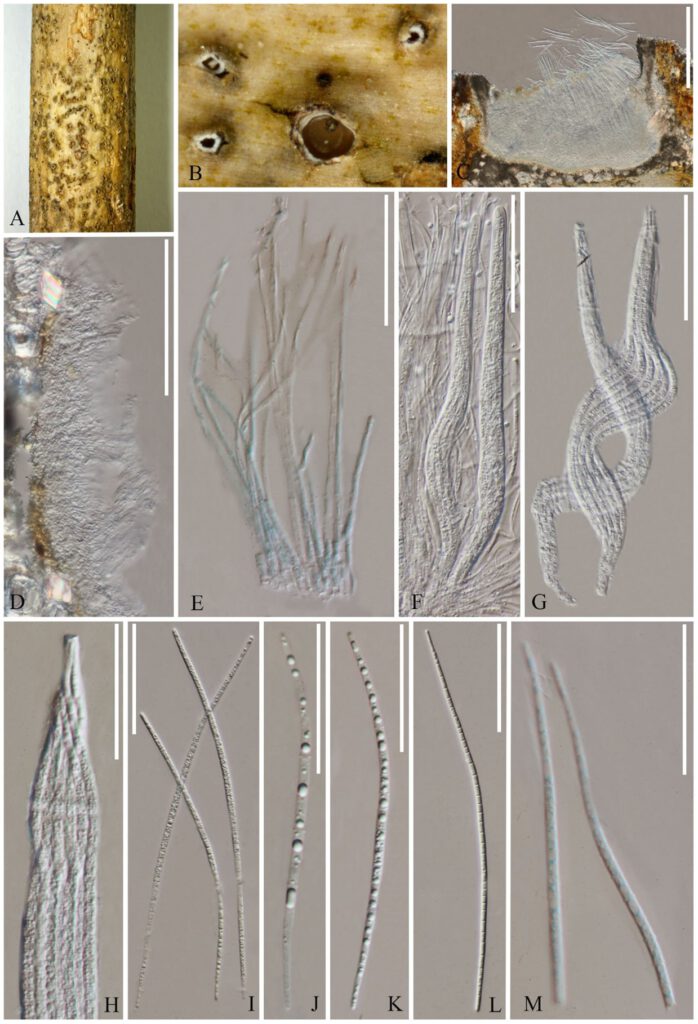Fitzroyomyces xishuangbannaensis R.F. Xu, K.D. Hyde & Tibpromma, sp. nov. (Fig. 3)
MycoBank number: MB 559624; Index Fungorum number: IF559624; Facesoffungi number: FoF 10811;
Holotype: HKAS 122682
Etymology: The specific epithet “xishuangbannaensis” refers to Xishuangbanna, in Yunnan Province where the holotype was collected.
Saprobic on rubber of Hevea brasiliensis. Sexual morph: Apothecial 235–430 high μm, 200–520 diam μm (x̅ = 300 × 400 μm, n = 10), subglobose, unilocular, gregarious, immersed from the substrate, immersed at first and opening by entire pore at maturity. Hypothecium convex. Disc deeply cupulate, whitish to cream. Margins white. Hymenium hyaline, enclosed in a thick gelatinous matrix. Epithecium absent. Excipulum 20–55 μm composed of cells of textura intricata. Paraphyses 1–2 μm wide at the apex, numerous, filiform, septate, unbranched. Asci 160–180× 10–20 μm (x̅ = 173 × 13 μm, n = 11), 8-spored, unitunicate, long cylindrical, short sessile, rounded at the apex. Ascospores 90–180 × 2–4 μm (x̅ = 152 × 3 μm, n = 10), filiform, hyaline, multiseptate, up to 35-septa, finely guttulate when immature. Asexual morph: Undetermined.
Material examined: CHINA, Yunnan Province, Xishuangbanna, on Hevea brasiliensis Muell. Arg, 30 July 2021, Ruifang Xu, XSBNR–20, (HKAS 122682, holotype).
Notes: The nucleotide base pair differences of ITS, LSU and mtSSU sequences are compared between our new species and members of Fitzroyomyces (Table 2). The new taxon was established based on the recommendations outlined by Jeewon & Hyde (2016). We also compared the morphology of our strain with Fit. cyperacearum, Fit. hyaloseptisporus, Fit. pandanicola and Fit. yunnanensis (Table 3). The difference between Fit. xishuangbannaensis and Fit. cyperacearum is that the larger apothecia (235–430 × 200–520 μm vs. 201–260 × 210–310 μm), wider exciple (17–70 μm vs. 20–55 μm), narrower paraphyses (17–70 μm vs. 24–54 μm), longer asci (110–150 × 10–20 μm vs. 160–180 × 10–20 μm), longer, and fusiform ascospore guttulate with more septation. Fitzroyomyces xishuangbannaensis differs from Fit. hyaloseptisporus in larger apothecia (235–430 × 200–520 μm vs. 140–200 × 150–200 μm), wider exciple (20–55 μm vs. 6–20 μm), smaller asci (160–180 × 10–20 μm vs. 165–200 × 10–25 μm) and ascospores (90–180 × 2–4 μm vs. 150–200 × 3.5–6 μm), further, ascospores are fuliform with more septation in Fit. hyaloseptisporus whereas Fit. xishuangbannaensis possesses filiform, hyaline, multiseptate ascospores finely guttulate when immature (Wei et al. 2021). Fitzroyomyces xishuangbannaensis and Fit. yunnanensis have the same geographical distribution in China (Lu et al. 2021) however, the two differ in several morphological characteristics such as Fit. yunnanensis has bigger apothecia, smaller asci, smaller ascospores and septation (Table. 3).
TABLE 2 Nucleotide differences in the ITS, LSU and mtSSU (not trimmed sequence) of Fitzroyomyces species.
| Species | Strains | ITS (%) | LSU (%) | mtSSU (%) |
| Fit. cyperacearum | CSB 143170 | 56/630 (8.9%) | 51/879 (5.8%) | – |
| Fit. hyaloseptisporus | MFLU 21-0114 | 72/620 (11.6%) | 33/841 (3.9%) | 65/756 (8.6%) |
| Fit. pandanicola | HKAS 96206 | 40/540 (7.4%) | 39/869 (4.5%) | 468/767 (61%) |
| Fit. yunnanensis | KUMCC 21-0002 | 49/546 (8.9%) | 23/903 (2.5%) | 80/855 (9.4%) |
TABLE 3. Morphological comparison of Fitzroyomyces species with the new species Fitzroyomyces xishuangbannaensis
| Species | Strain | Apothecia
(μm) |
Exciple (μm) | Paraphyses
(μm) |
Asci (μm) | Ascospores (μm) | Ascospores
shape |
Septation | References |
| Fit. cyperacearum | MFLU 17-1480 | 201–260 × 210–310 | 17–70 | 1.3–3 | 110–150 × 10– 20 | 100–145 × 2.5–3.5 | eguttulate
filiform |
17–21 | Ekanayaka. et al. (2019) |
| Fit. hyaloseptisporus | MFLU 21-0114 | 140–200 × 150–200 | 6–20 | 1–3 | 165–200 × 10–25 | 150–200 × 3.5–6 | guttulate
filiform |
up to 58 | Wei et al. (2021) |
| Fit. pandanicola | HKAS 96206 | 350–410 × 520–650 | 27–46 | 0.8–1.1 | 160–240 × 7.5–23 | 190–265 × 4–5 | eguttulate
fusiform |
up to 40 | Tibpromma et al. (2018) |
| Fit. yunnanensis | HKAS | 550–1000 × 230–370 | 25–50 | 1–2 | 100–140 × 6–10 | 80–115 × 2–3 | guttulate
fusiform |
12–18 | Lu et al. (2021) |
| Fit. xishuangbannaensis | HKAS 122862 | 235–430 × 200–520 | 20–55 | 1–2 | 160–180 × 10–20 | 90–180 × 2–4 | guttulate
fusiform |
up to 35 | This study |

FIGURE 3. Fitzroyomyces xishuangbannaensis (HKAS 122682, holotype). A–B Apothecia on a dead stem of Hevea brasiliensis. C Section of an apothecium. D Exciple. E Paraphyses with cotton blue reagent. F, Asci. H Tip of the asci. I–L Ascospores. M Ascospores stained with cotton blue reagent. Scale bars: C = 200 μm, D = 100 μm, E, H, J, K, M = 30 μm, F, G, I, L = 50 μm
